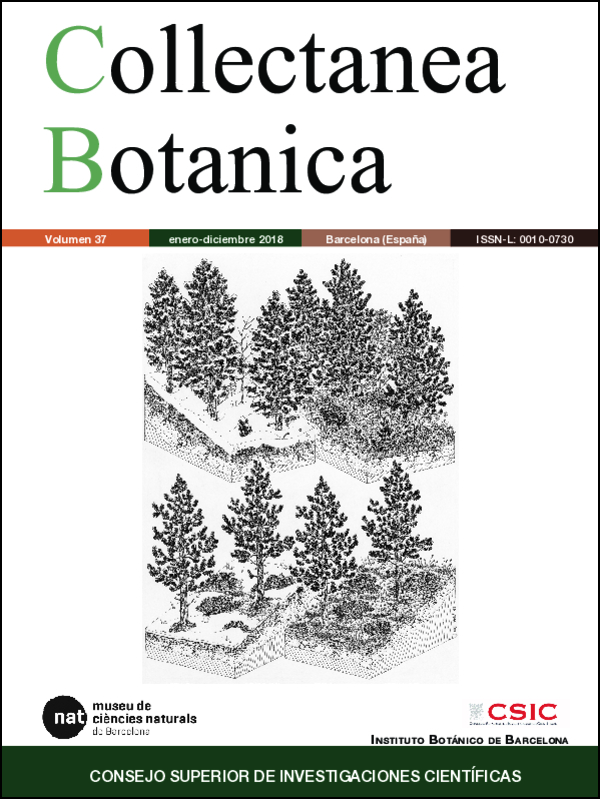Typification of two names in the genus Asperula (Rubiaceae)
DOI:
https://doi.org/10.3989/collectbot.2018.v37.008Keywords:
Asperula, lectotypification, Linnaeus, nomenclatureAbstract
The typification of two names in the genus Asperula, A. cynanchica subsp. pyrenaica and A. paui subsp. dianensis (Rubiaceae), applicable to species endemic to the Iberian Peninsula and France, is discussed. Specimens from UPS (Herbarium Burser, Uppsala University) and BC (Institut Botànic of Barcelona) are indicated and designated as lectotypes of, respectively, A. pyrenaica and A. paui var. dianensis
Downloads
References
Aizpuru, I., Aseginolaza, C., Uribe-Echebarría, P. M., Urrutia, P. & Zorrakin, I. 2015. Claves ilustradas de la flora del País Vasco y territorios limítrofes (1ª ed., 4ª reimp.). Servicio Central de Publicaciones del Gobierno Vasco, Vitoria-Gasteiz.
Bauhin, C. 1620. Prodromus theatri botanici. Typis Pauli Iacobi, impensis Ioannis Treudelii, Francofurti ad Moenum, 160 pp. Retrieved November, 2017, from http://bibdigital.rjb.csic.es/spa/Libro.php?Libro=1441&Hojas=
Bauhin, C. 1623. Pinax theatri botanici. Sumptibus & typis Ludovici Regis, Basileae.
Bolòs, O. & Vigo, J. 1983. Notes sobre taxonomia i nomenclatura de les plantes, II. Collectanea Botanica 14: 89–103.
Bolòs, O. & Vigo, J. 1996. Flora dels Països Catalans 3. Editorial Barcino, Barcelona.
De la Torre, A., Alcaraz, F. & Crespo, M. B. 1996. Aproximación a la biogeografía del sector Setabense (provincia Catalano-Valenciano-Provenzal). Lazaroa 16: 141–158.
Del Guacchio, E. & Caputo, P. 2005. Taxonomic notes on Asperula neglecta Guss. and Asperula nitens Guss. (Rubiaceae), and typification of their names. Webbia 60: 569–576. https://doi.org/10.1080/00837792.2005.10670787
Del Guacchio, E. & Caputo, P. 2013. Taxonomic notes on Asperula sect. Cynanchica (Rubiaceae). Taxon 62: 394–400. https://doi.org/10.12705/622.9
Ehrendorfer, F. & Krendl, F. 1976. Asperula L. In: Tutin, T. G., Burges, N. A., Chater, A. O., Edmondson, J. R., Heywood, V. H., Moore, T. M., Valentine, D. H., Walters, S. M. & Webb, D. A. (Eds.), Flora Europaea 3. Cambridge Unversity Press, Cambridge, London, New York & Melbourne: 4–9.
Ehrendorfer, F., Schönbeck-Temesy, E., Puff, C. & Rechinger, W. 2005. Rubiaceae. In: Rechinger, K. H. (Ed.), Flora Iranica 176. Verlag des Naturhistorischen Museums Wien, Vienna.
Ehrendorfer, F., Vladimirov, V. & Barfuss, M. H. J. 2014. Paraphyly and polyphyly in the worldwide tribe Rubieae (Rubiaceae): Challenges for generic delimitation. Annals of the Missouri Botanical Garden 100: 79–88. https://doi.org/10.3417/2012088
Ferrer-Gallego, P. P. 2015. Typification of the Linnaean name Asperula cynanchica (Rubiaceae). Phytotaxa 195: 98–100. https://doi.org/10.11646/phytotaxa.195.1.10
Gargiulo, R., Del Guacchio, E. & Caputo, P. 2015. Phylogenetic reconstruction of Asperula sect. Cynanchicae (Rubiaceae) reveals a mosaic of evolutionary histories. Taxon 64: 754–769. https://doi.org/10.12705/644.7
Govaerts, R., Ruhsam, M., Andersson, L. et al. 2012. World checklist of Rubiaceae. The Board of Trustees of the Royal Botanic Gardens, Kew.
IPNI [The International Plant Names Index] 2017. Retrieved July, 2017, from http://www.ipni.org
Jarvis, C. E. 2007. Order out the chaos. Linnaean plant names and their types. The Linnean Society of London in association with the Natural History Museum, London.
Juel, H. O. 1923. Studien in Burser's Hortus siccus. Nova Acta Regiae Societatis Scientiarum Upsaliensis, ser. 4-5, 7: 1–144.
Laguna, E., Crespo, M. B., Mateo, G. et al. 1998. Flora endémica, rara o amenazada de la Comunidad Valenciana. Consellería de Medio Ambiente, Valencia. PMCid:PMC1873371
Linnaeus, C. 1753. Species plantarum. Impensis Laurentii Salvii, Stockholm.
Mateo, G. & Crespo, M. B. 2014. Claves ilustradas para la flora valenciana (Monografías de Flora Montiberica, 6). Jolube, Jaca.
McNeill, J. 2014. Holotype specimens and type citations: General issues. Taxon 63: 1112–1113. https://doi.org/10.12705/635.7
McNeill, J., Barrie, F. R., Buck, W. R. et al. (Eds.) 2012. International Code of Nomenclature for algae, fungi, and plants (Melbourne Code) (Regnum Vegetabile, 154). Koeltz Scientific Books, Königstein.
Minareci, E. & Yıldız, K. 2011. Karyotype characterization of Turkish taxa of the genus Asperula L.- section Thlipthisa (Rubiaceae). Indian Journal of Genetics and Plant Breeding 71: 49–54.
Ortega-Olivencia, A. & Devesa, J. A. 2007. Asperula L. In: Devesa, J. A., Gonzalo, R. & Herrero, A. (Eds.), Flora iberica 15. Real Jardín Botánico (CSIC), Madrid: 36–56.
Peruzzi, L., Santangelo, A. & Jarvis, C. E. 2013. Lectotypification of Linnaean names in the Italian endemic flora. Taxon 62: 827–829. https://doi.org/10.12705/624.27
Rosselló, J. A. & Sáez, L. 2000. Index Balearicum: An annotated check-list of the vascular plants described from the Balearic Islands. Collectanea Botanica 25: 3–192. https://doi.org/10.3989/collectbot.2000.v25.42
Savage, S. 1937. Caroli Linnaei determinationes in Hortum Siccum Joachimi Burseri. The text of the manuscript in the Linnaean Collections. The Linnean Society, London.
Swingle, W. T. 1912. Clastotypes, clonotypes, and spermotypes, means for multiplying botanical name specimens. Journal of the Washington Academy of Sciences 2: 344.
Thiers, B. 2017. Index Herbariorum: A global directory of public herbaria and associated staff. New York Botanical Garden's Virtual Herbarium. Retrieved July, 2017, from https://www.nybg.org/science-project/index-herbariorum-upgrade
Published
How to Cite
Issue
Section
License
Copyright (c) 2018 Consejo Superior de Investigaciones Científicas (CSIC)

This work is licensed under a Creative Commons Attribution 4.0 International License.
© CSIC. Manuscripts published in both the print and online versions of this journal are the property of the Consejo Superior de Investigaciones Científicas, and quoting this source is a requirement for any partial or full reproduction.
All contents of this electronic edition, except where otherwise noted, are distributed under a Creative Commons Attribution 4.0 International (CC BY 4.0) licence. You may read the basic information and the legal text of the licence. The indication of the CC BY 4.0 licence must be expressly stated in this way when necessary.
Self-archiving in repositories, personal webpages or similar, of any version other than the final version of the work produced by the publisher, is not allowed.














